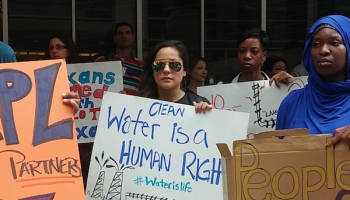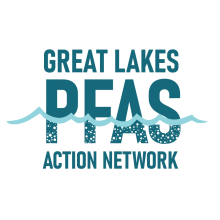A Community Unites to Tackle PFAS Pollution
In 2010, per and polyfluoroalkyl substances (PFAS) were discovered in the groundwater and water bodies in Oscoda, Michigan. The United States military used firefighting foam for decades at the former Wurtsmith Air Force Base, significantly contaminating local rivers, lakes, wildlife, and drinking water. The resulting advisories--"Do Not Eat Fish or Deer"--substantially impacted the Oscoda community which is known for its outdoor recreation.
In addition to these advisories, Oscoda residents were warned not to touch the white foam that bubbled on the shores of Van Etten Lake. Between 2019 and 2020, the Michigan Department of Environment, Great Lakes and Energy (EGLE) tested surface water foam on Van Etten Lake to learn how to best sample foam and better understand how it forms. During this time, white foam was noticeably forming along the public beaches and shores of Lake Huron. Community members became concerned about the source and the potential PFAS levels in the foam and water. Research indicates that foam ingestion is a potentially important route of exposure for children and adults when they are in surface waters where foam is present.
Since then, Oscoda-area community members have advocated for the State of Michigan and the U.S. Department of Defense to contain and clean up the contaminated sites and increase PFAS testing in water bodies. In 2017, Oscoda residents formed the grassroots group Need Our Water (NOW). As a result, NOW has engaged hundreds of Oscoda-area residents in fighting for clean water and protecting wildlife and human health.

State of Michigan's Foam Testing
The lack of consistent, comprehensive PFAS water monitoring in high-use areas and natural resources is a significant barrier to cleanup progress. The State of Michigan has tested surface water foam in contaminated areas for research; however, they do not regularly test foam around the state. Between 2018 and 2020, EGLE completed surface water foam samplings in highly contaminated inland rivers and lakes. All results were shared with the Michigan Department of Health and Human Services (MDHHS) to determine if foam advisories were needed. Advisories were issued at Van Etten Lake (Oscoda), Lake Margrethe (Grayling), Rogue River (Rockford), Thornapple River (Grand Rapids), and Huron River (S.E. Michigan). While MDDHS has issued a statewide general advisory to avoid foam on Michigan water bodies, the general advisory is not helpful in warning people at many water bodies where foam poses a risk like at Lake Huron beaches.
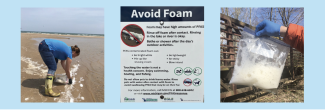
Testing Lake Huron for PFAS foam is vital to keeping communities safe from toxic exposure.
NOW requested that EGLE's Water Resources Division prioritize Lake Huron foam in their water quality monitoring location. This testing was essential because there are no advisory warnings on the public beaches to avoid the foam, and people and children touch and play with the foam. It was particularly concerning that children may have been inadvertently ingesting foam, increasing their PFAS exposure.
EGLE declined requests to monitor foam on Lake Huron multiple times. They stated that existing surface water data was sufficient to determine human health regulations for drinking water ingestion and fish consumption. Additionally, they stated that because the State of Michigan does not have a standard for PFAS in surface water foam no assessment could be conducted.
In 2021, NOW joined the Ecology Center, the National Wildlife Federation, and the Michigan League of Conservation Voters to form the Great Lakes PFAS Action Network. Through this new community-driven coalition the resources and skill sets were available to create a community-science monitoring project. Thanks to funding from the Americana Foundation, NOW, the Ecology Center, and the National Wildlife Federation formed a community-based monitoring project to sample the foam and create a replicable model for other communities.
A Model for Community-Science
Community science values the lived experiences and expertise that community members bring to research in their communities. In this project, NOW worked with the Ecology Center and National Wildlife Federation to define the primary issues, establish goals, and determine the collection sites.
The project was started with these goals:
- Provide consistent monitoring data to the Oscoda-area community.
- Understand the concentrations of PFAS foam in Lake Huron.
- Make a strong case for why EGLE should test the foam and provide more advisory signage.
Potentially illustrate the connection between PFAS contamination and Wurtsmith in areas deemed 'outside' of Wurtsmith contamination plumes.
What is PFAS-containing Surface Water Foam?
Turbulence and wave action in water bodies introduces air into organically enriched water and can make foam. PFAS foam is usually bright white in color, lightweight, and may pile up along shores or blow onto beaches. Naturally occurring foam may also contain PFAS. PFAS can concentrate in things like sediment, aquatic animals, and surface water foam. This means that PFAS levels can be much higher in foam than in the surrounding surface water.
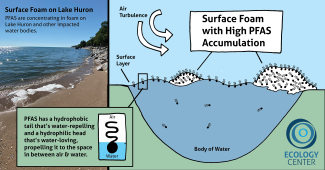
Collection Methods
NOW members monitored the beaches between May 2022 and June 2023 for surface water foam.
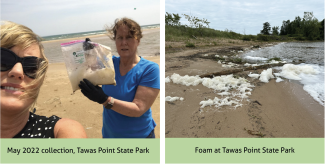
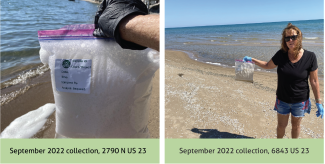
Collection Sites
NOW partnered with the Ecology Center for training in PFAS collection protocols, following EGLE's Surface Water Foam PFAS Sampling Guidance. Using nitrile gloves NOW members scooped foam into one-gallon ziploc bags. They placed ziploc bags into coolers and immediately delivered to Enviro Lab Services in Oscoda for analysis.
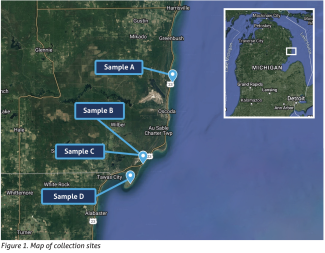
NOW collected four samples at the following locations on Lake Huron:
Sample A: 6843 US 23, September 8, 2022
Sample B: 2790 US 23, September 8, 2022
Sample C: 2790 US 23, June, 2023
Sample D: Tawas Point State Park, May 20, 2022
Results
PFOS and PFUnA were found in all Lake Huron foam samples. A combination of other PFAS were found in each sample as well. Sample D (Tawas State Park) had the highest levels of PFAS at 7,900 ppt. For comparison, the state of Michigan regulates seven PFAS in drinking water including 8ppt for PFOA and 16ppt for PFOS. The state does not have maximum contaminant levels for PFAS in surface water foam.

PFAS are impacting the Great Lakes
- PFAS chemicals are likely coming from multiple sources into Lake Huron.
- Every Lake Huron foam sample contained PFAS.
- Samples from Tawas Point State Park on Lake Huron had the highest total PFAS at 7,900 ppt.
- All four samples contained PFOS. This is consistent with other foam sampling done across Michigan.
- All four samples contained PFUnA.
PFAS are concentrating in foam on Lake Huron and other impacted water bodies
Due to certain chemical properties, PFAS can concentrate throughout the environment in places like water, foam, fish, and other wildlife. The more contaminated a water body is, the higher the PFAS levels will be in foam. In fact, PFAS in foam can be up to 5,000 times higher than in subsurface water. This ratio between the subsurface water and the foam is called the “enrichment factor". Understanding this ratio demonstrates how PFAS concentrates in the environment.
All foams tested in Lake Huron and other EGLE waterbody samples contained concentrated levels of PFAS. PFAS concentrates in the thin surface water micro layer (about the thickness of a human hair) at the surface of water bodies. This layer typically contains the highest PFAS concentration in a water body.
Action Needed!
EGLE and MDHHS should set health-protective policies for Lake Huron foam. These include publicly available testing and data, foam advisories, and increased public education.
Signage needs to be permanently installed on Lake Huron high-use beaches and shorelines to educate the public on visual indications of PFAS foam and alert about the dangers of touching PFAS foam.
